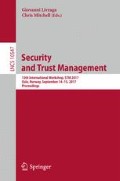Abstract
Attack trees allow a security analyst to obtain an overview of the potential vulnerabilities of a system. Due to their refinement structure, attack trees support the analyst in understanding the system vulnerabilities at various levels of abstraction. However, contrary to manually synthesized attack trees, automatically generated attack trees are often not refinement-aware, making subsequent human processing much harder. The generation of attack trees in which the refined nodes correspond to semantically relevant levels of abstraction is still an open question. In this paper, we formulate the attack-tree generation problem and propose a methodology to, given a system model, generate attack trees with meaningful levels of abstraction.
Access this chapter
Tax calculation will be finalised at checkout
Purchases are for personal use only
References
Dawkins, J., Hale, J.: A systematic approach to multi-stage network attack analysis. In: Proceedings of the Information Assurance Workshop. IEEE (2004)
Fraile, M., Ford, M., Gadyatskaya, O., Kumar, R., Stoelinga, M., Trujillo-Rasua, R.: Using attack-defense trees to analyze threats and countermeasures in an ATM: a case study. In: Horkoff, J., Jeusfeld, M.A., Persson, A. (eds.) PoEM 2016. LNBIP, vol. 267, pp. 326–334. Springer, Cham (2016). doi:10.1007/978-3-319-48393-1_24
Gadyatskaya, O.: How to generate security cameras: towards defence generation for socio-technical systems. In: Mauw, S., Kordy, B., Jajodia, S. (eds.) GraMSec 2015. LNCS, vol. 9390, pp. 50–65. Springer, Cham (2016). doi:10.1007/978-3-319-29968-6_4
Gillis, N., Glineur, F.: A continuous characterization of the maximum-edge biclique problem. J. Global Optim. 58(3), 439–464 (2014)
Gadyatskaya, O., Jhawar, R., Kordy, P., Lounis, K., Mauw, S., Trujillo-Rasua, R.: Attack trees for practical security assessment: ranking of attack scenarios with ADTool 2.0. In: Agha, G., Van Houdt, B. (eds.) QEST 2016. LNCS, vol. 9826, pp. 159–162. Springer, Cham (2016). doi:10.1007/978-3-319-43425-4_10
Ghani, H., Luna Garcia, J., Petkov, I., Suri, N.: User-centric security assessment of software configurations: a case study. In: Jürjens, J., Piessens, F., Bielova, N. (eds.) ESSoS 2014. LNCS, vol. 8364, pp. 196–212. Springer, Cham (2014). doi:10.1007/978-3-319-04897-0_13
Hong, J.B., Kim, D.S., Takaoka, T.: Scalable attack representation model using logic reduction techniques. In: Proceedings of the TrustCom. IEEE (2013)
Ivanova, M.G., Probst, C.W., Hansen, R.R., Kammüller, F.: Transforming graphical system models to graphical attack models. In: Mauw, S., Kordy, B., Jajodia, S. (eds.) GraMSec 2015. LNCS, vol. 9390, pp. 82–96. Springer, Cham (2016). doi:10.1007/978-3-319-29968-6_6
Jhawar, R., Kordy, B., Mauw, S., Radomirović, S., Trujillo-Rasua, R.: Attack trees with sequential conjunction. In: Federrath, H., Gollmann, D. (eds.) SEC 2015. IAICT, vol. 455, pp. 339–353. Springer, Cham (2015). doi:10.1007/978-3-319-18467-8_23
Kordy, B., Mauw, S., Radomirovic, S., Schweitzer, P.: Attack-defense trees. Oxford Univ. Press J. Logic Comput. 24(1), 55–87 (2014)
Lenzini, G., Mauw, S., Ouchani, S.: Security analysis of socio-technical physical systems. Elsevier Comput. Electr. Eng. 47, 258–274 (2015)
Mauw, S., Oostdijk, M.: Foundations of attack trees. In: Won, D.H., Kim, S. (eds.) ICISC 2005. LNCS, vol. 3935, pp. 186–198. Springer, Heidelberg (2006). doi:10.1007/11734727_17
Pinchinat, S., Acher, M., Vojtisek, D.: Towards synthesis of attack trees for supporting computer-aided risk analysis. In: Canal, C., Idani, A. (eds.) SEFM 2014. LNCS, vol. 8938, pp. 363–375. Springer, Cham (2015). doi:10.1007/978-3-319-15201-1_24
Pinchinat, S., Acher, M., Vojtisek, D.: ATSyRa: an integrated environment for synthesizing attack trees. In: Mauw, S., Kordy, B., Jajodia, S. (eds.) GraMSec 2015. LNCS, vol. 9390, pp. 97–101. Springer, Cham (2016). doi:10.1007/978-3-319-29968-6_7
Peeters, R.: The maximum edge biclique problem is NP-complete. Discrete Appl. Math. 131(3), 651–654 (2003)
Ritchey, R.W., Ammann, P.: Using model checking to analyze network vulnerabilities. In: Proceedings of the S&P Symposium, pp. 156–165. IEEE (2000)
Roy, A., Kim, D.S., Trivedi, K.: Attack countermeasure trees (ACT): towards unifying the constructs of attack and defense trees. Secur. Commun. Netw. 5(8), 929–943 (2012)
Schneier, B.: Attack trees: modeling security threats. Dr. Dobb’s J. Softw. Tools 24(12), 21–29 (1999)
Sheyner, O., Haines, J., Jha, S., Lippmann, R., Wing, J.M.: Automated generation and analysis of attack graphs. In: Proceedings of the S&P Symposium, pp. 273–284. IEEE (2002)
Shostack, A.: Threat Modeling: Designing for Security. Wiley, Hoboken (2014)
Vigo, R., Nielsen, F., Nielson, H.R.: Automated generation of attack trees. In: Proceedings of the CSF, pp. 337–350. IEEE (2014)
Acknowledgements
The research leading to these results has received funding from the European Union Seventh Framework Programme under grant agreement number 318003 (TREsPASS) and from the Fonds National de la Recherche Luxembourg under grant C13/IS/5809105 (ADT2P).
Author information
Authors and Affiliations
Corresponding author
Editor information
Editors and Affiliations
Rights and permissions
Copyright information
© 2017 Springer International Publishing AG
About this paper
Cite this paper
Gadyatskaya, O., Jhawar, R., Mauw, S., Trujillo-Rasua, R., Willemse, T.A.C. (2017). Refinement-Aware Generation of Attack Trees. In: Livraga, G., Mitchell, C. (eds) Security and Trust Management. STM 2017. Lecture Notes in Computer Science(), vol 10547. Springer, Cham. https://doi.org/10.1007/978-3-319-68063-7_11
Download citation
DOI: https://doi.org/10.1007/978-3-319-68063-7_11
Published:
Publisher Name: Springer, Cham
Print ISBN: 978-3-319-68062-0
Online ISBN: 978-3-319-68063-7
eBook Packages: Computer ScienceComputer Science (R0)

